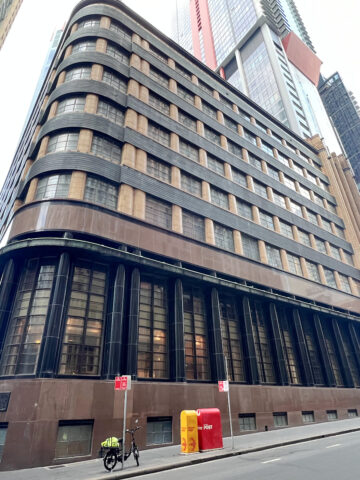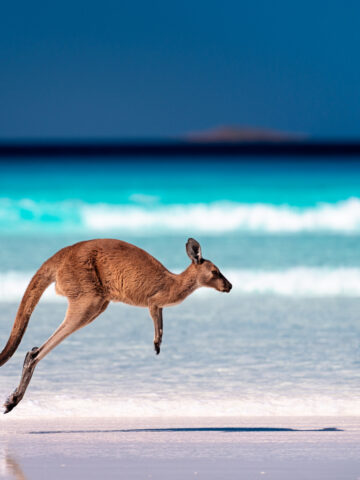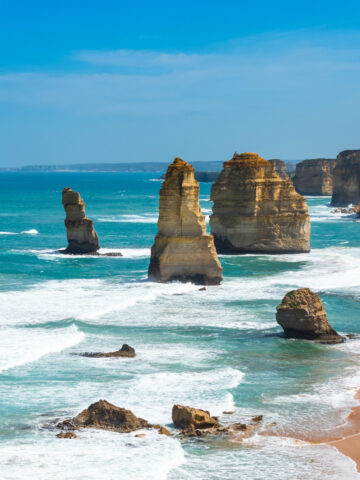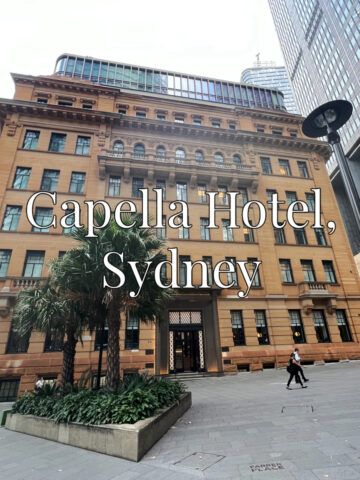Australian food is influenced by migrants who traveled to Australia over the years - from the British who colonized Australia in the late 18th century, through to the Italians and Greeks who came to Australia in the years following World War II, and into the 1970s and later by migrants from Asia and later the Middle East.
Some of these foods may be familiar to you, but they each have their own Australian "twist". A visit to Australia is not complete without trying at least a sampling of Australian food.
Jump to:
Meat Pie

When it comes to Australian food, I think that the humble meat pie likely tops the list. The closest thing to a meat pie in the US is a "pot pie", but that doesn't begin to describe it. A meat pie is traditionally a "takeaway" food item, held with the hand, and eaten at sporting events. There are pie shops all over the country, selling varieties ranging from the traditional minced (ground) beef, through to curry pies.
Make sure that you get some "tomato sauce" (known as ketchup in the US) to top your pie (although I prefer the English HP sauce!)
Fish & Chips

A meal of Fish & Chips is typically associated with the UK, but they are just as popular in Australia, with "fish & chip shops" found in every city, town, and suburb in Australia. When I was growing up, we had takeaway fish & chips every Friday night, and more than anything, when I return to Australia to visit, I crave some Aussie fish & chips. Nothing in the US has come close to the Australian fish & chip experience!
Chiko Roll

The Chiko Roll is similar in a Chinese spring roll, but with a sturdier casing, making it easy to eat on the move; it's available at fish and chip shops and other "takeaways" (aka a takeout restaurant) inspired by the Chinese spring roll. It was invented in 1951 as the "Chicken Roll" despite not actually containing chicken. The filling is mostly cabbage and barley, as well as carrot, green beans, beef, beef tallow, wheat cereal, celery and onion. Like the meat pie, it's a popular snack to eat at a football game.
Chicken parmigiana ("Chicken parm")
I know, I know. Chicken Parmigiana is NOT exclusive to Australia, but it's a "pub" staple in Australia, and is a must try if you do visit a pub while in Australia. It's traditionally served with chips (as are most pub foods in Australia if I'm being honest), or a salad; it's often also available as a sandwich.
Not to get off track, but if you're looking for a good pub, I recommend visiting Young & Jackson's in Melbourne, at the intersection of Swanson & Flinders Streets - it's Australia's most iconic hotel. Head upstairs for the dining room, and stop by and say "hello" to Chloe, a nude portrait which has hung on the walls of Young & Jackson for over a century.
Burger with "the lot"
Again, not an Australian invention, but Australian burgers "with the lot" are piled high with ingredients, including an over-easy egg, a slice of canned beetroot, and a slice of pineapple. It's definitely requires the use of two hands to keep it all together.
Barbecued snags (aka sausages)
Nothing says "Australian barbecue" like a grilled sausage (either beef or pork) served on a piece of white bread, topped with grilled onions. As a tourist, the easiest way to get a barbecued "snag" is to go to the local Bunnings hardware store (Bunnings is the Australia equivalent of the US' Home Depot). Bunnings stores across the country hold a "sausage sizzle"* where you can get a grilled sausage on white bread (with or without grilled onions) for $A3.50, and a soft drink for $A2. Bargain!
* A sausage sizzle is a social event held outdoors at which sausages are cooked and sold, often in order to raise money for charity. You can read more about the Bunnings' sausage sizzle for charity here.
Pavlova

Pavlova is a meringue-based dessert. There is some debate as to whether it originated in Australia or New Zealand. Sorry, Kiwis, but I'm claiming pavlova as Australia's own! It was named after the Russian ballerina Anna Pavlova. It's a confection of baked meringue, crisp on the outside, sot and light on the inside, and filled with whipped cream, and almost any variety of fruit. Personally, I'm a big fan of passionfruit, so I love mine with passionfruit, strawberries and raspberries.
Lamington

A lamington is a sponge cake made in a pan, and cut into square before being coated in an outer layer of chocolate sauce and rolled in desiccated coconut. It can also be made with layers with strawberry jam in between the layers.
Lamingtons are sold at local bakeries, but they are also popular during school fundraisers (such as cake sales).
Vegemite

This might be one of the most polarizing Australian foods out there! Vegemite had somewhat humble beginnings in Melbourne - it started out as a substitute for Marmite due to wartime shortages following the First World War. It's now a symbol of Australia that's loved by young and old alike. Traditionally eaten on toast or sandwiches, but it can be used as a seasoning in casseroles etc.
The trick to eating vegemite is to use it in moderation. It's best eaten on buttered toast. Take care to only add a smear of vegemite to your toast - don't spread it like peanut butter!
Fairy Bread

This is a "bonus" food item because unless you're attending a child's birthday party in Australia, you're not likely to come across "fairy bread", a staple at every young child's birthday party.
Fairy bread is white bread with butter, loaded with "hundreds and thousands", the Australian team for nonpareils. Traditionally served sliced in triangles - it's a cheap party food!
And a bonus... Chicken Salt
This one is actually not a food, but a seasoning. It's name is a misnomer, as there is no chicken contained in chicken salt (it's vegetarian). It's a seasoning that was originally used for seasoning rotisserie chickens. It's now popularly used on chips instead of regular table salt.
Conclusion
I've only scratched the surface of Australian foods you must try when visiting Australia - if you've been to Australia, what has been your favorite food? Let me know in the comments!





Nigel
Quote: "British who colonized Australia in the late 17th century", 1788 is in the 18th century Susan...Just saying....
Susan
Good point!! I've updated the post 🙂